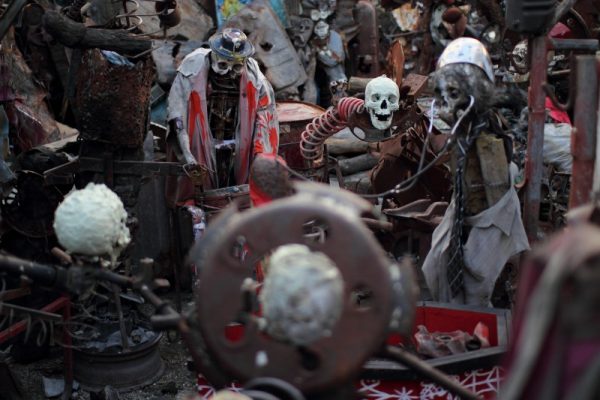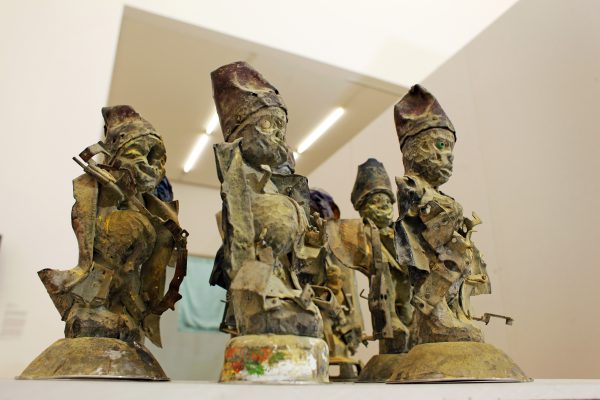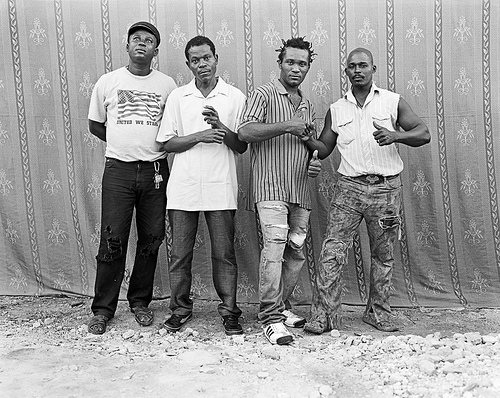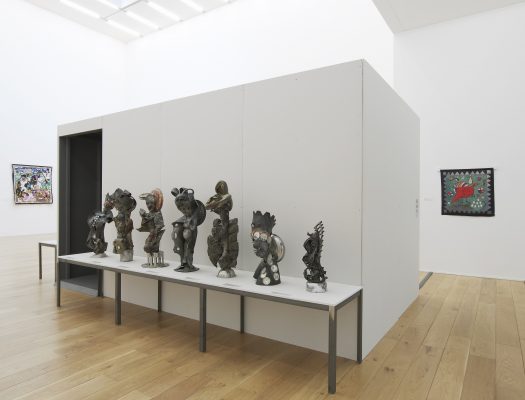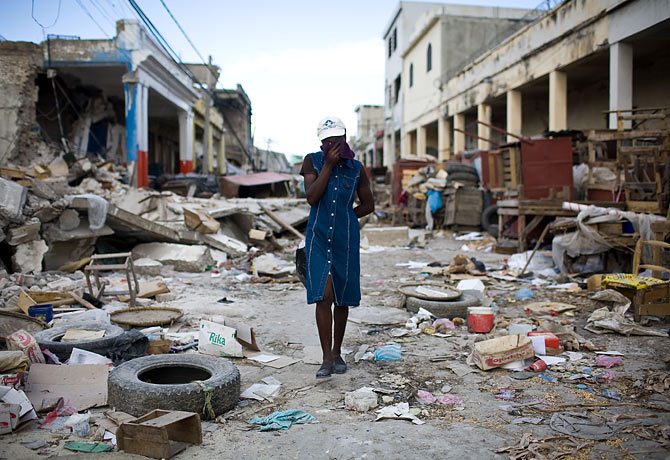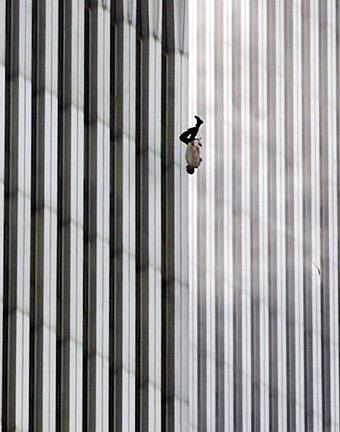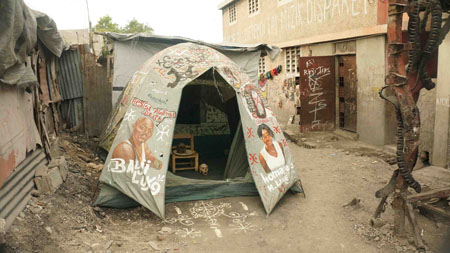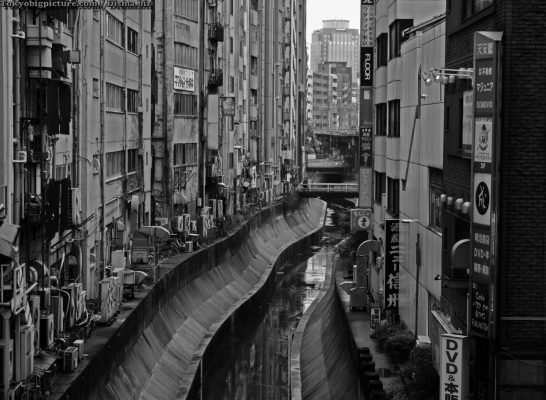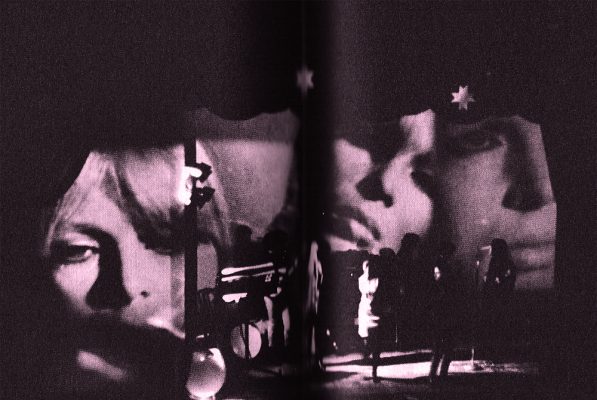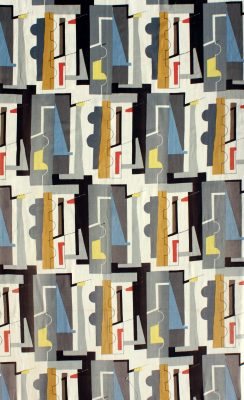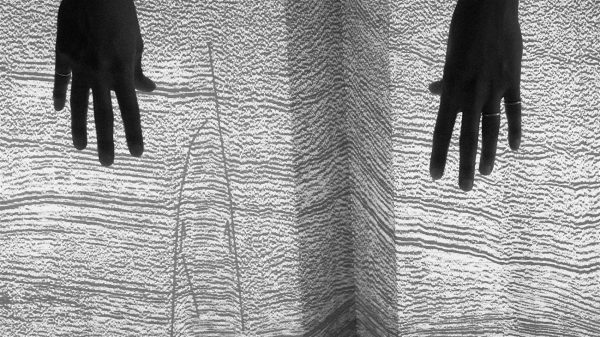Thousands of Haiti’s poorest call it home: Grand Rue, a district of Port-au-Prince once run by merchants and bankers, now populated by people living in corrugated metal shells. For several months after the earthquake in January 2010 that killed over 300,000 Haitians, the dead continued to line its streets. Corpses queued for the cemeteries, their bodies stacked on top of each other, awaiting a turn for temporary interment before making way for another’s remains.
The modernist envelope that is Nottingham Contemporary, the city’s landmark art centre, is as far from downtown Port-au-Prince as you’re likely to get. Yet its recent exhibition Kafou: Haiti, Art and Voudou, was a significant attempt to present to a new audience the attempts of an artistic community to find expression for the experience of communal trauma. I want to contrast these works against more familiar examples of Western artists’ articulation of large-scale tragedy.
The suffering that seems ubiquitous to Haitian life is inherent to its culture, embodied in Baron Samedi, a dandified embodiment of death and fertility who has smirked his way through Haitian voudou for centuries. At the show in Nottingham — alongside Haitian art dating back to the 1940s — Grand Rue is partly represented as a series of sculptures by Atis Resiztans (AR), a contemporary artistic group from the district who employ found materials such as human skulls, tyres or wooden blocks to construct fearsome ritualistic statues of Haitian spirits. Their humour is apparent in their incorporation of such things as the high-heeled shoes sent by US human rights charities, despite their being obviously inappropriate for Haiti’s roads. After several minutes of watching a film about the group directed by the show’s co-curator, Leah Gordon, glued to your seat in horror, amusement and awe, you begin to adjust to AR’s attitude. Its artists laugh at their effigies’ dicks, huge and bouncy and emblematic of the nation’s fertility and desire to rebuild. AR smirk at journalists who could never understand their culture. And they laugh at death.
Consumers of American and European culture are certainly used to self-reflexive, clever, amusing artworks, but they are not used to laughing over first-hand experience of death. Any large-scale tragedy is succeeded by a considerable period of soul-searching about the right time, and the correct method, to represent the gravity of events without recourse to offence, insensitivity or opportunism.
In order to try to explain the importance of work by AR on a wider stage — and to explain how effective it is in its gallery context — I’ve decided to run through three other artworks, all of which are recent North American attempts by artists to tackle instances of public mourning. Two of these works touch on 9/11. I aim to demonstrate that the Haitian artists’ work provides as illuminating an insight into public mourning as these most celebrated Western reactions to tragedy.
Don Delillo’s celebrated 2007 novel Falling Man is named after the iconic and often censored 9/11 Associated Press image of a man falling from the Twin Towers.
Falling Man is considered by many to be among Delillo’s greatest works because it recounts the destructive scenario which for many years his paranoid worlds hinted must come to pass. It follows the movements of a 9/11 survivor, Keith, his on-off relationship with his estranged wife Lianne, and his affair with a fellow survivor, Florence. The majority of the novel considers the alienation that accompanies the experience of tragedy, and also includes the occasional vignette about art’s capacity to tackle such subjects. This role is embodied in a performance artist, called Falling Man, who affixes himself upside down to a harness and leaps out at commuters: after his death he is attacked by New York’s mayor for his crassness. Delillo’s artist embodies the inability of art to do justice to reality, which plays upon our own interpretation of the novel. In its final pages we have a real-time walk through of what it might have been like to escape from the Twin Towers as they were falling: the dust, the smoke, the numbness. The reader is awed and overwhelmed by the magnitude of what occurred, shocked into an anaesthesia that has its roots in incomprehension.
Falling Man and AR’s sculptures address themes of religion, anger and control through similar imagery. Dellilo uses Islam — an account of the terrorists and their reliance on Allah — and Christianity — through Keith’s wife, who rediscovers the comfort of church — to explore human behaviour. Similarly, for AR the spirit and real worlds do not just collide, like paths at a crossroads, but co-exist. Much of its work depicts the many and the varied voudou spirits, including the Gede, the spirit group to which Samedi belongs (the Gede represent both death and fertility, and mothers, babies and penises frequently figure in AR’s work). In both Dellilo and AR a sense of anger is joined by helplessness in the face of forces beyond the individuals’ control.
Bill Viola’s Observance — part of his famous video art series, The Passions — shows a series of actors approaching a camera in slow motion and responding to an unknown stimulus, which the viewer must assume is horrific from the actors’ reaction. Viola gave the actors minimal direction apart from warning them when they were drifting out of the frame, so many of them are responding to some internal motivation of their own choosing which manifests itself in physical grief or mourning. It is widely speculated that the work was made in response to 9/11, but Viola didn’t instruct the actors along these lines: as such it is a somewhat disconnected depiction of communal grief, which when viewed in the sanitised space of a gallery, or within the illuminated frame of a cinema, is intended to prompt a response from the viewer. It largely succeeds, using a relatively modern medium to explore familiar imagery (aesthetically, at least, Observance is based on Albrecht Dürer’s The Four Apostles from 1526). Critics have, famously, broken down in tears in front of Viola’s work. One explanation for their vulnerability to the work’s effect is that, as in the closing pages of Falling Man, we are presented with a non-intellectual expression of the sublime (Cynthia Freeland, a philosophy professor at the University of Houston, says as much in a 2004 essay). It doesn’t matter that these are actors: their depictions of grief force us to consider how we respond to depictions of tragedy.
Viola is not afraid of blurring the lines between the feeling one might get when stepping in front of an emotive artwork and witnessing death itself. He believes art, according to the art historian John Walsh, ‘can have a healing function’ and the Passions was created after the death of Viola’s father. In 1998, while a visiting scholar at the J. Paul Getty Museum in Los Angeles, Viola wrote in his notes about seeing a man die in the street upon arriving to work one day. ‘His face was pale white, hands limp at his side, grey hair swaying every time the medic pumps his chest.’ Viola’s response? He doesn’t tell anyone about it or seek support; instead he goes into the museum to find his ‘special painting’, Dieric Bout’s Annunciation from the 1450s. As he leaves the institution later on the same day he notes that ‘the man was gone’, and he thinks of his dad.
Viola uses artworks – his own and others – as a crutch, a vehicle for the articulation of emotional reaction to trauma. In Observance Viola (who is at present creating a video work to be permanently installed in St Paul’s Cathedral in London) appropriates Christian iconography and other religious sources (namely Sufism), and foregrounds the ritual in the protagonists’ actions. In its ceremonial nature it recalls the work of AR, as both are monuments to grief. Nonetheless, Observance is undermined, for me, by its artifice, its employment of actors and the unavoidable fact that everyone depicted in the video seems to be a middle-class white collar worker. It’s hard not to notice that the cultures and social groups most likely to produce highly-visible, widely exhibited ‘masterpieces’ are also those least likely to experience grief on a national scale. I can’t help feeling that the developed world would have a better idea of mass mourning if it queued to see Haitian artists’ work as it does to see Viola’s.
That impression is reinforced by the commercial and critical success afforded to Netherland, Joseph O’Neill’s 2008 novel about a Dutchman in post 9/11 New York (excepting an infamous drubbing from Zadie Smith in the New York Review of Books). The novel develops themes of renewal and alienation, seeking to provide a non-American perspective on the period of national mourning that succeeded that tragedy. Despite its occasional flashes of anger at, among other things, the injustices of American society, its ultimate message is a positive one. It is about rebirth: New York will always build itself anew, whatever it has to endure. Whether that sentiment is true or useful, one does wonder why an account that focuses on the world’s most powerful city is perceived to have greater authority on the subject of suffering than artwork from a country which has suffered tribulations including slavery, starvation, revolution, mass poverty, natural disaster, exploitation, colonisation and dictatorship. Why are those voices so little heard?
The Ghetto Biennale in Port-au-Prince was founded in 2008 after AR artists were refused tourist visas to attend a private view of their work in the US (and at least one of them, as the show opened, had been denied entry into the UK to see the Nottingham exhibition). In Haiti, the first biennale was held in December 2009, hosted by Atis Rezistans and co-curated by Myron Beasley and Leah Gordon, and the second in December 2011. While the biennale is an extraordinary expression of cultural expression, the mere fact that these artists’ work should have been so ghettoized is a cause for regret and reflection.
